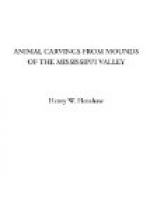As in the Cass of the manatee, it has been thought well to introduce a correct drawing of a toucan in order to afford opportunity for comparison of this very striking bird with its supposed representations from the mounds. For this purpose the most northern representative of the family has been selected as the one nearest the home of the Mound-Builders.
The particulars wherein it differs from the supposed toucans are so many and striking that it will be superfluous to dwell upon them in detail. They will be obvious at a glance.
Thus we have seen that the sculptured representation of three birds, totally dissimilar from each other, and not only not resembling the toucan, but conveying no conceivable hint of that very marked bird, formed the basis of Squier and Davis’ speculations as to the presence of the toucan in the mounds. These three supposed toucans have been copied and recopied by later authors, who have accepted in full the remarks and deductions accompanying them.
At least two exceptions to the last statement may be made. It is refreshing to find that two writers, although apparently accepting the other identifications by Squier and Davis, have drawn the line at the toucan. Thus Rau, in The Archaeological Collections of the United States National Museum, pp. 46-47, states that—
The figure (neither of the writers mentioned appear to have been aware that there was more than one supposed toucan) is not of sufficient distinctness to identify the original that was before the artist’s mind, and it would not be safe, therefore, to make this specimen the subject of far-reaching speculations.
[Illustration: Fig. 18.—Keel-Billed Toucan of Southern Mexico (Rhamphastos carinatus.)]
Further on he adds, “Leaving aside the more than doubtful toucan, the imitated animals belong, without exception, to the North American fauna.” Barber, also, after taking exception to the idea that the supposed toucan carving represents a zygodactylous bird, adds in his article on Mound Pipes, pp. 280-281 (American Naturalist for April, 1882), “It may be asserted with a considerable degree of confidence that no representative of an exclusively exotic fauna figured in the pipe sculptures of the Mound-Builders.”
PAROQUET.
The presence of a carving of the paroquet in one of the Ohio mounds has been deemed remarkable on account of the supposed extreme southern habitat of that bird. Thus Squier and Davis remark ("Ancient Monuments of the Mississippi Valley,” p. 265, Fig. 172), “Among the most spirited and delicately executed specimens of ancient art found in the mounds, is that of the paroquet here presented.”




